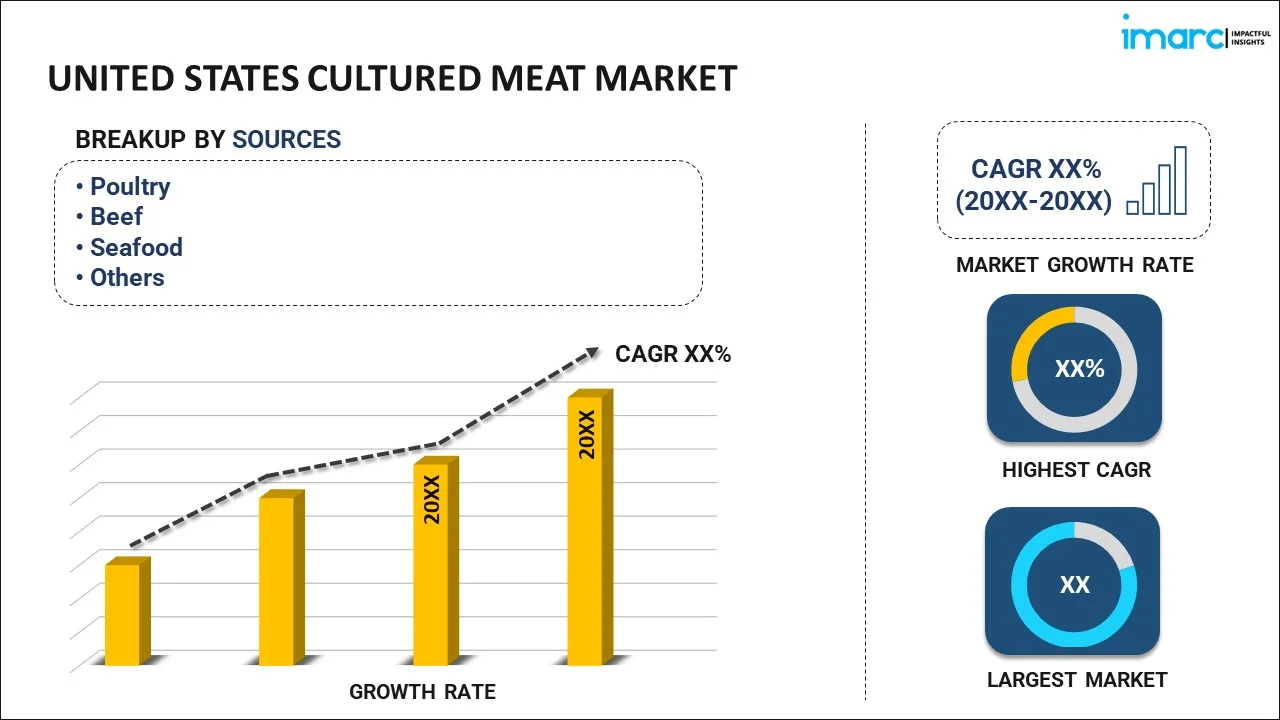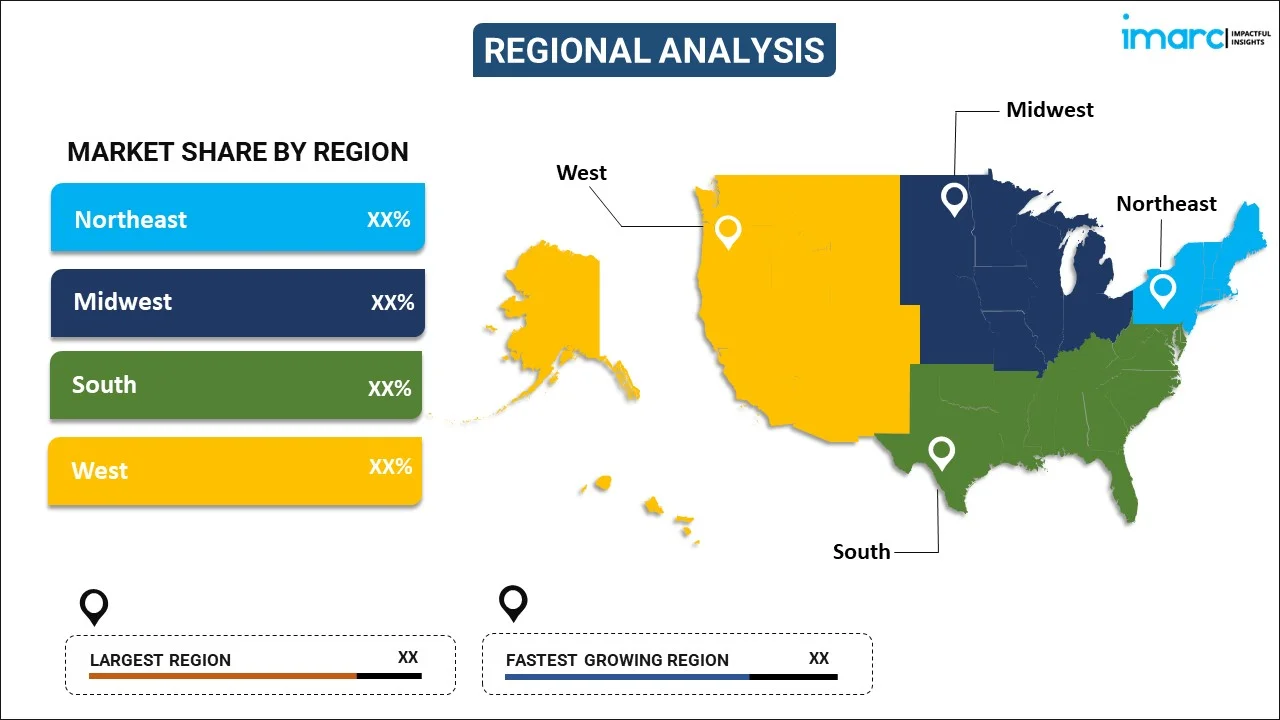
United States Cultured Meat Market Report by Source (Poultry, Beef, Seafood, Pork, Duck), Application (Nuggets, Burgers, Meatballs, Sausages, Hot Dogs), End User (Household, Food Services), and Region 2025-2033
Market Overview:
United States cultured meat market size reached USD 57.8 Million in 2024. Looking forward, IMARC Group expects the market to reach USD 1,133.9 Million by 2033, exhibiting a growth rate (CAGR) of 34.68% during 2025-2033. The ongoing advancements in tissue engineering, biotechnology, and cell culture techniques, which can make the cultured meat production more scalable and cost-effective, are driving the market.
|
Report Attribute
|
Key Statistics
|
|---|---|
|
Base Year
|
2024 |
|
Forecast Years
|
2025-2033
|
|
Historical Years
|
2019-2024
|
| Market Size in 2024 | USD 57.8 Million |
| Market Forecast in 2033 | USD 1,133.9 Million |
| Market Growth Rate (2025-2033) | 34.68% |
United States Cultured Meat Analysis:
- Major Drivers: The heightened environmental consciousness propels demand for sustainable protein sources. The United States cultured meat market growth is driven by biotechnology advancements making production more efficient and scalable. Increasing investments from private players and government bodies accelerate commercialization and technological development significantly.
- Key Market Trends: Growing interest among health-conscious consumers in cleaner, antibiotic-free protein options positively influence market expansion. The United States cultured meat market share benefits from regulatory approvals creating consumer confidence. Rising urbanization and population growth surge demand for resource-efficient protein alternatives nationwide.
- Market Challenges: High production costs and scalability issues remain significant barriers to widespread commercial adoption. Consumer acceptance challenges persist due to unfamiliarity with cell-based meat technology. Regulatory complexities and varying approval processes across states create market entry difficulties.
- Market Opportunities: Technological innovations in 3D bioprinting and tissue engineering create opportunities for texture improvement. The United States cultured meat market demand presents opportunities for partnerships between food companies and biotechnology firms. Expanding applications beyond traditional meat products offer new market segments.
Cultured meat, also known as lab-grown or cell-based meat, is a revolutionary approach to producing meat products without traditional animal farming. It involves cultivating animal cells in a controlled environment, such as a bioreactor, where they multiply and develop into muscle tissue. This process mimics the natural growth of meat inside an animal but occurs outside the animal's body. Researchers harvest a small sample of animal cells and provide them with the necessary nutrients to encourage growth. The result is a product that closely resembles conventionally produced meat, both in taste and texture. Cultured meat has the potential to address various ethical, environmental, and sustainability concerns associated with traditional meat production, including the reduction of greenhouse gas emissions, land use, and animal welfare issues. As technology advances, the development of cultured meat continues to gain momentum, offering a promising alternative to conventional livestock farming.
United States Cultured Meat Trends:
Technological Advancement and Production Scaling
The United States cultured meat market growth is witnessing revolutionary technological breakthroughs in 2025. Companies are implementing advanced 3D bioprinting techniques and plant-based scaffolding to create meat products virtually indistinguishable from traditional meat. These innovations address previous texture and structure limitations, making cultured meat more appealing to consumers. Bioreactor technology improvements enable larger-scale production, reducing costs significantly. Cell culture media optimization enhances growth efficiency while maintaining product quality. Major investments in production facilities demonstrate industry confidence in scaling capabilities. These technological advances position the market for rapid commercial expansion and mainstream adoption.
Regulatory Environment Evolution
The regulatory landscape for cultured meat continues evolving rapidly, creating new opportunities and challenges. USDA approvals for companies like UPSIDE Foods and GOOD Meat mark significant milestones for commercial sales authorization. However, state-level restrictions, including Texas's two-year ban effective September 2025, create regional market complexities. Federal agencies are developing comprehensive safety frameworks addressing consumer protection and industry standards. International regulatory harmonization efforts facilitate global market expansion opportunities. The United States cultured meat market analysis indicates regulatory clarity will drive investor confidence and market growth. These developments shape competitive dynamics and influence strategic planning across the industry.
Consumer Acceptance and Market Penetration
Consumer attitudes toward cultured meat are shifting positively, driven by environmental and ethical considerations. Health-conscious consumers increasingly seek antibiotic-free, cleaner protein alternatives, boosting United States cultured meat market demand. Educational initiatives by companies and advocacy groups improve public understanding of production processes and benefits. Restaurant partnerships provide controlled introduction environments for consumer trials. Premium positioning strategies target environmentally conscious and health-focused demographics initially. Market research indicates younger consumers show higher acceptance rates for innovative protein alternatives. Social media influence and sustainability messaging contribute to changing perceptions. These factors collectively accelerate market penetration and mainstream acceptance.
United States Cultured Meat Market Segmentation:
IMARC Group provides an analysis of the key trends in each segment of the market, along with forecasts at the country level for 2025-2033. Our report has categorized the market based on source, application, and end user.
Source Insights:

To get more information on this market, Request Sample
- Poultry
- Beef
- Seafood
- Pork
- Duck
The report has provided a detailed breakup and analysis of the market based on the source. This includes poultry, beef, seafood, pork, and duck.
Application Insights:
- Nuggets
- Burgers
- Meatballs
- Sausages
- Hot Dogs
A detailed breakup and analysis of the market based on the application have also been provided in the report. This includes nuggets, burgers, meatballs, sausages, and hot dogs.
End User Insights:
- Household
- Food Services
The report has provided a detailed breakup and analysis of the market based on the end user. This includes household and food services.
Regional Insights:

- Northeast
- Midwest
- South
- West
The report has also provided a comprehensive analysis of all the major regional markets, which include Northeast, Midwest, South, and West.
Competitive Landscape:
The market research report has also provided a comprehensive analysis of the competitive landscape in the market. Competitive analysis such as market structure, key player positioning, top winning strategies, competitive dashboard, and company evaluation quadrant has been covered in the report. Also, detailed profiles of all major companies have been provided.
Recent News and Development:
- In September 2025, Californian startup Mission Barns sold its cultivated pork for the first time at an exclusive dinner in San Francisco’s Sunset District. The event, held at Fiorella, featured dishes like Sicilian-inspired meatballs and Applewood-smoked bacon layered with the company’s cultivated fat. CEO Cecilia Chang highlighted chef Brandon Gillis’s creative use of the pork. The dinner follows USDA approval for Mission Barns’ cultivated pork fat and is the first of three pop-up events, with another scheduled for September 24.
- In March 2025, Mission Barns, a startup producing cultivated pork fat in bioreactors, secured FDA clearance, marking the first U.S. approval for cell-cultivated pork fat. Founder Eitan Fischer hopes it will revitalize the struggling cultivated meat industry. The fat will feature in meatballs and bacon at Fiorella in San Francisco and Sprouts Farmers Market. Combining plant-based proteins with small amounts of cultivated fat, Mission Barns becomes the first globally to gain regulatory approval for pork fat for human consumption.
United States Cultured Meat Market Report Coverage:
| Report Features | Details |
|---|---|
| Base Year of the Analysis | 2024 |
| Historical Period | 2019-2024 |
| Forecast Period | 2025-2033 |
| Units | Million USD |
| Scope of the Report | Exploration of Historical and Forecast Trends, Industry Catalysts and Challenges, Segment-Wise Historical and Predictive Market Assessment:
|
| Sources Covered | Poultry, Beef, Seafood, Pork, Duck |
| Applications Covered | Nuggets, Burgers, Meatballs, Sausages, Hot Dogs |
| End Users Covered | Household, Food Services |
| Regions Covered | Northeast, Midwest, South, West |
| Customization Scope | 10% Free Customization |
| Post-Sale Analyst Support | 10-12 Weeks |
| Delivery Format | PDF and Excel through Email (We can also provide the editable version of the report in PPT/Word format on special request) |
Key Benefits for Stakeholders:
- IMARC’s industry report offers a comprehensive quantitative analysis of various market segments, historical and current market trends, market forecasts, and dynamics of the United States cultured meat market from 2019-2033.
- The research report provides the latest information on the market drivers, challenges, and opportunities in the United States cultured meat market.
- Porter's five forces analysis assist stakeholders in assessing the impact of new entrants, competitive rivalry, supplier power, buyer power, and the threat of substitution. It helps stakeholders to analyze the level of competition within the United States cultured meat industry and its attractiveness.
- Competitive landscape allows stakeholders to understand their competitive environment and provides an insight into the current positions of key players in the market.
Key Questions Answered in This Report
The cultured meat market in the United States was valued at USD 57.8 Million in 2024.
The United States cultured meat market is projected to exhibit a CAGR of 34.68% during 2025-2033, reaching a value of USD 1,133.9 Million by 2033.
The need to reduce greenhouse gas emissions, conserve water, and optimize land use drives demand for alternative protein sources. Advancements in biotechnology, tissue engineering, and cell culture techniques make production more efficient and scalable, while increasing investments from private players and government bodies accelerate commercialization and consumer adoption.
Need more help?
- Speak to our experienced analysts for insights on the current market scenarios.
- Include additional segments and countries to customize the report as per your requirement.
- Gain an unparalleled competitive advantage in your domain by understanding how to utilize the report and positively impacting your operations and revenue.
- For further assistance, please connect with our analysts.
 Request Customization
Request Customization
 Speak to an Analyst
Speak to an Analyst
 Request Brochure
Request Brochure
 Inquire Before Buying
Inquire Before Buying




.webp)




.webp)












